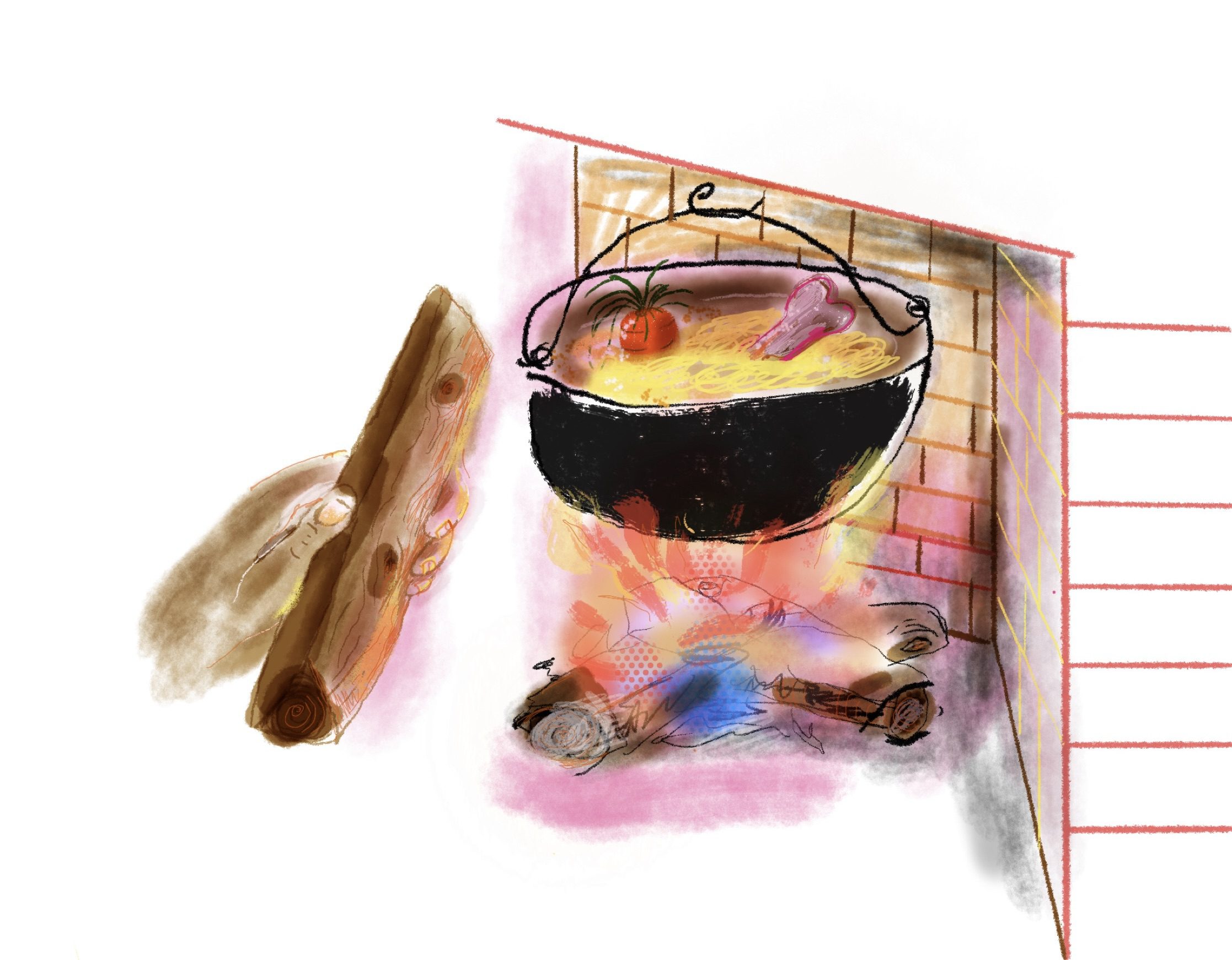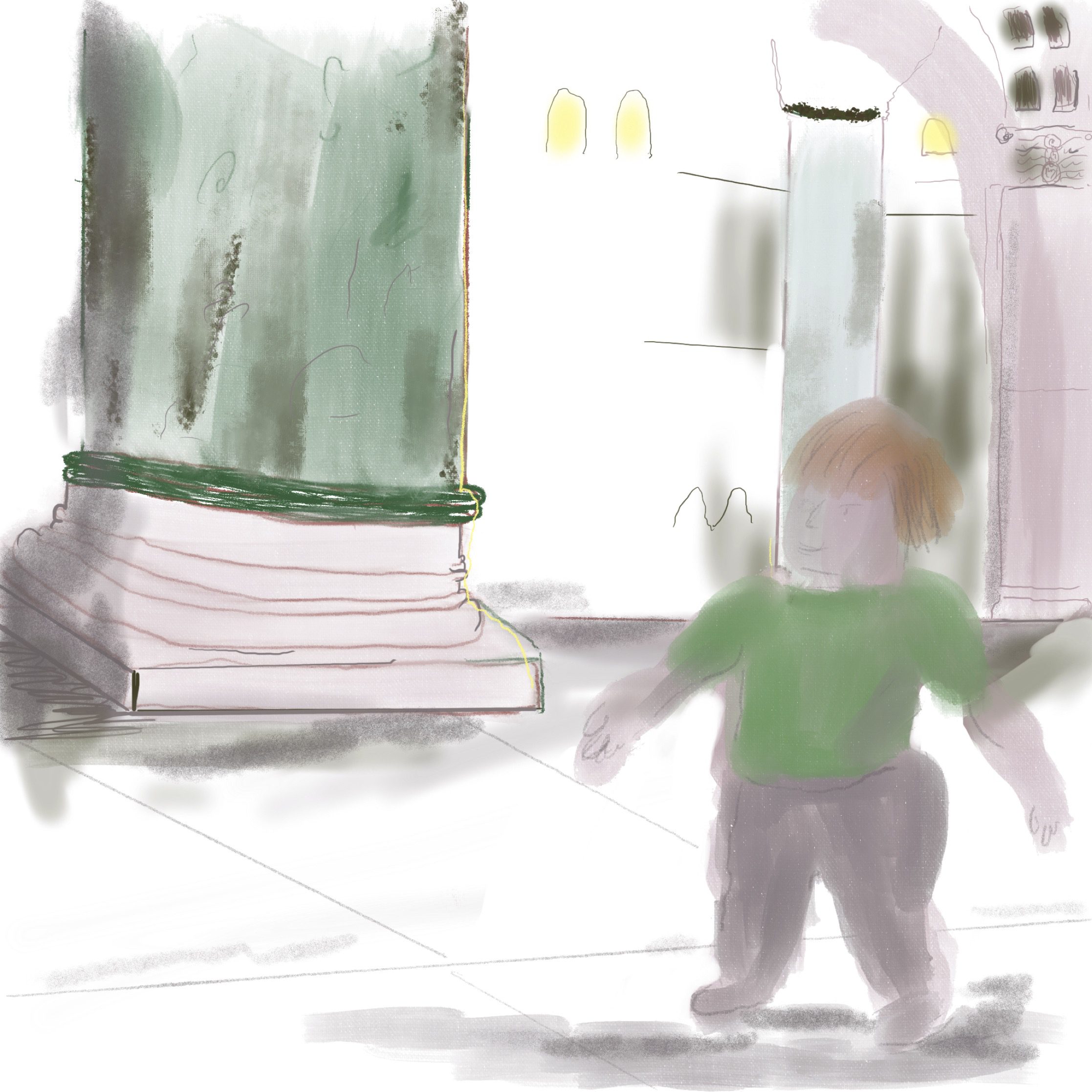The making of bone broth is tedious. It requires tending; it is an investment in the future. When my husband, Mark, traveled to France for a conference, I rejected the boxed shortcut and chose the long way, that well-worn path taken by others throughout history; I chose to conjure my food from bone, vegetable, water, and time.
I am not known for my success in the domestic arts. Mark’s cooking forays almost always involve dinner on the table at 6pm and sputtering pots of many sizes and function, all ready to go at once. In contrast, my meals were usually ready later at night; involved several frantic trips to the store for missing ingredients; and resulted in bland one-pot concoctions or, when things were not salvageable, resulted in snacks for dinner.
I could have just purchased broth, and it would have been tasty and easy. Stores stock all manner of broths: fancy, small-batch prepared liquids in the freezer section; powders; concentrates; shelf-stable liquids—small glass jars, plastic bags, cartons, tetra packs.
Like many who grew up in America during the late 80’s, quick foods have always appealed to me. Frozen pudding on a stick, macerated rolled fruit, and tiny tinned sausages are all perfectly acceptable foods. Whatever I thought I wanted could be unboxed or pried open, and unwrapped. Back then, for me, everything was fast: dinner came from the drive-through, friendships blazed like matches, and love hit hard and quick. But, now, in my forties, I want to be a part of the making. I want to build something from its most elemental parts as my thoughts swirl in tandem with a wooden spoon. I would join the ranks of those who heated up water and waited, who dedicated their time, their hours, toward care. Learning a new task, like cooking or chanting a mantra, hems you in with humanity, and you take your turn, your moments or decades, in the timelessness of tending. Electric burners have replaced open fires, but work remains the same; we labor, and we wait.
Mark and I had, together, purchased the necessary ingredients before his trip. After dropping off our daughter at a Saturday dance class, we had driven to the local Farmers’ Market, where the blue-eyed man with an impressive mustache who always gave our daughter a hothouse tomato pulled out a double-wrapped plastic baggie of two large, juicy bones. I was happy we were able to get them. Broth bones have become increasingly harder to find. Once sold by the butcher for dog treats, they have now achieved a foodie status. The cost of bones has gone up steeply with their demand.
It started well. Broth-making seemed like a good vigil to keep during Mark’s travels. I released the bones from their packet, threw away the bloody plastic, and roasted them in the oven. I cut a yellow onion into four pieces. Carrots from the vegetable bin and a few garlic cloves joined the bones and onion on the cookie sheet. The ingredients browned at 450-degrees for forty minutes. The roasted bones, filtered water, and overcooked vegetables tumbled into the soup pot. I added bay leaves and a few peppercorns. But then I started to worry. How long can I leave this? Can I shower? Can it really cook all night? A small panic ensued.
More a natural researcher than cook, I learned that to temper concerns about fire and ruining the stove’s element, some broth-ers buy little, low-temperature burners; crockpots and rice cookers could also do the job, but others question the amount of lead in slow cookers. Our crockpot and rice cooker both elude me—too many buttons, weighty lids. Some use an oven-proof pot to simmer the broth all night long in the oven. Coming from a family that conserved even half-smoked cigarettes, leaving the oven on all night to make broth seemed wasteful and dangerous. I was grateful to learn some leave their broth on the stove to cook in short spurts, as opposed to days, bringing it back to a boil for an initial ten minutes to zap any botulism or other deadly bacteria that might have plumed during the cooling-off time. I turned off the stove before bed, uninterested in spending the night in sleepless worry about an impending fire or a ruined oven.
On Broth Day 2, I started texting complaints to Mark. It feels like the broth is chronic. I want it to end. My project felt tedious, and boring, tying me to one room of the house because I was still afraid to leave the broth alone. My daughter walked by; wrinkled her nose; and remarked, “That smells strong.” The meat-steam filling the house definitely signaled work. When I finally turned off the stove to strain everything, the house smelled like flesh, the vegetables had turned saggy and sad, and I felt dispirited. On the other hand, the broth water had changed to a thick, dark brown with an oily surface, evidence of transformation.
I poured the liquid into a ceramic mug, sipped it, and spat it out. The French have a word for those three essential vegetables used together as a soup or broth base, mirepoix. I had included carrots and onion but not celery. I understood why there was a word for that particular combination, and I learned the consequence of leaving one of them out.
The broth was not my first tending project. The previous summer, I went through a kefir phase. It needed to be fed fresh milk about once a day—every day. The excess grains had to be removed so that a new batch could start. Feeding the kefir was too much of a job for me; I grew tired of tending it, or worrying about it, when we needed to go out of town. I just buy it these days, a little guiltily, when I want it. A few autumns ago, Mark took over the kombucha, another, ongoing tending that I’d started. Sanitizing bottles, steeping green tea with sugar, removing the excess rubbery scobies, and constantly fearing bacterial contamination was a lot, and every few batches was a dud. How could I leave the house for a week when the kombucha needed a second fermentation?
“Tend” is a word my grandmother used for several caregiving activities, including tending the garden and tending the children. When I think of tending the broth, I see myself rolling the bones around, skewering their middle to release the marrow, and stirring the pot’s contents from time to time. It reminds me of how my grandmother tended the fire, the poker turning the blazing logs until they sparked against one another, embers yielding flames for hours on end.
I grew up comfortably in North Carolina. Our split-level house had a large wood-paneled den and a difficult-to-maintain, below-ground pool in the backyard. My grandmother’s room beside the den had a door leading to the carport, where she sat in a ragged, wicker chair, enjoying five cigarettes per day. Nannie carefully put out each half-cigarette, storing it in her repurposed Altoids box to revive during her next break.
The den housed a wood-burning stove that heated the downstairs. Every year, Nannie asked for kindling for both Christmas and her November birthday, and sometimes my white-haired uncles from Raleigh would bring over truckloads of wood. Outside, the chopped logs were stacked against the windows, ready to go. The kindling stayed in little metal buckets by the stove.
Tending the fire meant keeping it going, and this was Nannie’s work. It required lighting the paper or pine straw, feeding wood to the stove, prodding the coals, and helping the fire to glow slowly. I recently asked my older sister what else one tended to. She suggested babies, crops, farm animals, and food. One tends to a garden by tilling and watering the soil; to farm animals by watering and milking them; to meat in the oven by basting or dressing it; and to babies by keeping them safe, happy and alive. In my grandmother’s North Carolina dialect, tending connoted a kind of essential, time-consuming care. Tending has a thickness to it—it entails attention, time, and something like sacrifice.
In college, I had a jolly, older professor of Latin and ancient Greek who, over wine and cheese at his house, loved to let words devolve and effervesce in his mouth, tending to their changes over time. My favorite was whiskey. He told a story of going to Amsterdam and trying to speak Dutch, but he hesitated to do so before us until he had had a few drinks. As he loosened up his tongue, the Dutch would come out. The word whiskey would rasp and morph into the Scandinavian akvavit, then into the Latin aqua vitae, the water of life. It was a beautiful thing to behold, the word churning through the ages within one man’s imagination and out of his voice box. I could hear the blending of cultures, the Roman, Germanic, and Anglo Saxon, all drunk together, slurring words, becoming one. Our language and gestures invoke ancient histories, bringing the past into the present. We stir the bones.
Was tend from tengo, to stretch and to strive? As I tended to the broth, so many verb tenses washed over my brain, words I had not expected to remember, irregular verbs that refused to be normalized rose up in my memory. But none seemed right for to tend. The internet suggested several origins and meanings in both Old English (attend: to look after) and Latin (to stretch). Tending might have something to do with fire, one explanation offered; perhaps the word shares its beginnings with the notion of fire starting, to set fire to, to kindle, to ignite.
Ignite is another favorite cognate. These fiery words spark all kinds of metaphors and ideas, and their embers are from the very oldest articulations of language. Although ignite comes from Latin, ignis, it has roots in the proto-Indo-European word that became Agni, the god of fire and fire itself, in Vedic mythology. Fire is tended to and is required for tending (lighting up and looking after) both the hearth and the funeral pyre—the tedious of the everyday and the final end of life.
I have tended one thing with some success. I have a child whom I nourished in utero. She was born full of both folate and essential fatty acids because of all the sardines and avocadoes I ate, mostly for her benefit. My midwife bragged that my pregnancy diet was a model for other pregnant women to follow. I fed and watered that little spirit-turned-human during her time inside my body. When I became sick with swollen ankles and nausea, overheated and falling from a bus, I set aside my research in Turkey and returned to the United States in order to tend to that little life. Today, I continue to tend to her needs and desires, stirring my sweet eleven-year-old pot.
When she was learning to walk, my daughter took some tentative steps inside Istanbul’s Hagia Sophia, a physical monument to cultural blending. When the area was conquered by the Ottomans, the Byzantine church was transformed into a mosque. The walls are covered with blacked-out faces of Christian icons, interspersed with scripture from the Quran. To a toddler, this was a very fine, open space for toddling. I loved the thought of her treading over stones where humans have walked and prayed and visited for centuries as beliefs shifted and changed forms. Her little steps reignited those stones as sacred space, as others have done since 537 AD.
At the stove, I was considering a decision—where shall we send my daughter to middle school? Who will take care of her and teach her? What will she learn? And what will she be taught? She needed to be put into good hands. I want to ask her future teachers: Will you tend to her? Will you keep her fire going? I have seen my daughter on fire. When she learned to read, she sped through the leveled readers and into all the Harry Potter books before second grade. Multiplication made sense to her, and she quickly applied it to real-life situations. Before she could read, she composed gorgeous, moving poems inspired by the ocean, clouds, and flowers. Formal learning has little draw, but these days she enjoys a good pun and sculpting little creatures out of marzipan.
Her coals are still warm; her imagination can be rekindled. A good school will invest in her learning; her development will be time consuming and arduous, but for a child who can easily memorize a song or a fact or a poem after hearing it once, real intellectual growth requires recursion, deepening, raising the bar, and revision. Little penciled-in bubbles of discrete facts are the quick opposite of what she needs to thrive in the world. I want her to be skilled; thoughtful; and attentive to building slow, worthwhile connections.
Before my daughter was born, fire seemed loud, fast, explosive, and dazzling: flash pots, fireworks, flame throwers. I was once drawn to the short, scorching pyrotechnics show of an outdoor concert. But my tastes and desires have changed. In terms of my daughter’s tending, her survival will be covered: There will be a water fountain, and she will stay with her flock. But I care about stoking her curiosity. Who will help her fire burn? At one of the schools we visited, the children take a class called “Life,” where they learn to cook and sew and build fires. It appeals to me endlessly, intellectually, because she will learn while doing—she will use her hands to make what humans, for millennia, have made.
***
Rumpus original art by Liam Golden.








